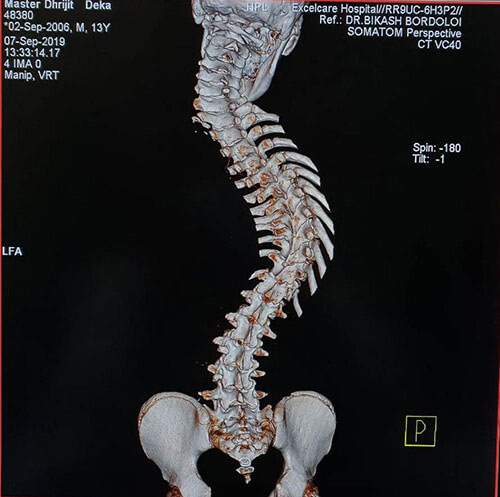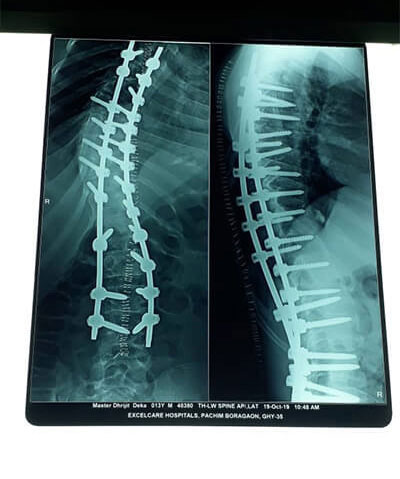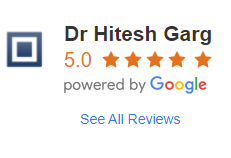-
How to fully correct severe spine deformity? Scoliosis ? Kyphosis? Kyphoscoliosis.
If you or your child need treatment, your doctor might suggest:
Braces
In children who are still growing, it is advised to wear a brace around the torso which can stop the curve from getting worse. They're usually made of plastic or other synthetic material. Many kids wear have to wear them 24 hours a day. It does not hamper the daily routine or activities of the child and it can't be seen under the clothes. It is very effective for flexible deformities of idiopathic scoliosis of small/medium curve. Braces are custom made for the child after taking the measurement and adjusting to the correction required. It is normally changed every 6 months as the child grows in length and the curve reduces.Non-fusion technique
Non fusion techniques like growing rods are specially indicated for idiopathic and congenital scoliosis. It is a minimally invasive procedure which allows growth of the child as well as curve correction. Non Fusion techniques may involve magnetic or non magnetic growing rod. The advantage of using magnetic growing rod is that the distraction can be done as an OPD procedure without the need for surgery every 6 months.
Spinal fusion surgery
In this operation, your surgeon puts pieces of bone or a similar material between bones in your spine to fuse them. They use the implants (screws and rods) to hold the bones in place until they grow together, or fuse as one segment. This kind of surgery can decrease the angle of the deformed curve in your spine as well as keep it from getting worse. Spinal Fusion surgeries are normally done after the age of 10 or 11 years as by then the torso has grown completely and lung maturation has reached to a reasonable level. Spinal Fusion surgeries provide a permanent solution as they hold the curve in corrected position and does not allow future worsening of the curve.
Spine and rib-based growing operation
This is done to correct more serious scoliosis in children who are still growing. The surgeon attaches rods to your spine and ribs with implant. As you grow, the surgeon adjusts the length of the rods. Patient does not experience any significant discomfort while adjustments of the hardware. This technique requires regular inter-spaced distraction off the device as the correction is a gradual process and takes up too many years. In this type of correction Fusion is not done and the child continues to grow at the torso as well. This type of procedure has a particular advantage as it also provides space for the lung to grow.
If the curve (cobb's angle) is less than 40 Degrees it can be fully corrected by just bracing and exercises. However if the curve is more than 40 Degrees it requires surgery in the form of spinal fixation (putting screws & rods) , derotation of bones, curve/deformity correction and sometimes bone cutting procedure known as osteotomy is required as well.
-
What is Scoliosis?
Kyphosis?
Kyphoscoliosis ?Scoliosis is a sideways curve in your backbone (or spine). Often, it first shows up when you're a child or teenager. The angle of the curve may be small, medium or large. But anything that measures more than 10 degrees on an X-ray is considered scoliosis. Doctors may use the letters "C" and "S" to describe the curve. Normally small curve is less than 60 degrees, medium between 60-90 degrees and large is more than 90 degrees. scoliosis may be as a result of Bony defect (called as congenital scoliosis) or as a result of nerve or muscle problem (called as neuromuscular scoliosis) or there may not be any underlying pathology at all.(called as idiopathic scoliosis. )
Kyphosis is a spinal condition in which, the spine curves forward more than it should ( more than 60 degrees). As a result, the upper back looks overly rounded. The curvature can make people looked hunched or slouching. People sometimes call it ‘hunchback’ or ‘round back’. It is mostly because of infection or some fracture or some form of Bony abnormality like fused vertebra or incompletely formed vertebra in the spine. Sometimes kyphosis can be because of age related weakening of the vertebras and age related Bony fractures in the spine.
Kyphoscoliosis is a combination of outward curvature (kyphosis) and lateral curvature (scoliosis)
-
Proven methods to fully correct spine deformities
Common treatments for spinal deformity from non-surgical to surgical include:
- Observation and monitoring, particularly in young children, to ensure the spinal curvature does not progress. This is usually done if the child is less than 10 years of age and the curve angle called as cobbs angle is less than 40 degrees.
- Bracing to hold the spine in alignment. bracing allows the curve to correct slowly or hold the curve in same position till the final surgery is done.
- Physical therapy and lifestyle changes to include more exercise in order to strengthen back muscles. Children are encouraged to do back and abdomen exercises to keep the muscles around the spine strong. This is very important for holding the curve incorrect position before surgery and after surgery it helps in early mobilization of the kid.
- Finally surgery is the ultimate solution if the curve is of congenital origin or is more than 40 degrees in case of neuromuscular or idiopathic variety. Fusion surgeries include procedures like putting screws and rod along with cutting the bone as specific positions called as osteotomies or vertebral column resection to strengthen the spine.
- Lung problems that include difficulty in breathing due to severe curvature of the mid-back ,pressing onto the lungs and giving limited space to the lungs for expansion .
- Inability to perform activities of daily living, such as walking or dressing, due to postural problems from a curved spine. This can be made worse by progressive nerve and muscle weakness in the pelvis and lower limbs over a period of time.
- Loss of sensation in the legs, incontinence, or reduced sexual function due to nerve compression in the lower back . It is important to understand here that in case of large curves which are over 100 degrees in cobb's angle measurement this type of progressive paralysis eventually develops over a period of time. Sometimes it can develop very rapidly over a period of few months in case of kyphoscoliotic deformity of spin specially as a result of traumatic or infective primary pathology.
- Pain due to compressed spinal nerves or muscle spasms. slowly as the curve progresses eventually pain developes at the back in all types of scoliosis due to degeneration of facet joints and disc in the spine.
- Extreme cases of curve angle more than 140 degrees may cause the curved spine and the ribs to start pressing the internal abdominal organs also leading to difficulty in eating and digestion, and frequent symptoms like vomiting and abdominal pains .
-
Follow these simple steps to correct the deformity
Whatsapp your X-ray film to +91 9958500258.
Get free expert opinion by Dr.Hitesh Garg (senior consultant and head of spine surgery at Artemis hospital Gurgaon )
Fix an appointment in Artemis Hospital, Gurgaon call +91-8377004016
Life free of deformities and taboo!
-
What are the major types of Scoliosis?
Congenital:
Since birth due to bony abnormalities (half formed, fused bones or absent bones). Congenital scoliosis occurs in only 1 in 10,000 new borns and is much less common than idiopathic scoliosis which usually becomes evident in adolescence. Congenital scoliosis may also be associated with sagittal plane abnormalities such as kyphosis and lordosis. Congenital scoliosis is normally fast growing and more rigid in presentation as compared to idiopathic scoliosis. Also congenital scoliosis requires surgery at a much earlier age (normally between 3 to 5 years) and often requires a Bony procedure for correctionNeuromuscular scoliosis:
It is a spinal curvature that develops secondary to some kind of neurological or muscular disease, such as muscular dystrophy or cerebral palsy. This form of scoliosis tends to progress much more quickly than others. The curves of neuromuscular scoliosis can be of flaccid or rigid type depending on the underlying pathology of the curve. The curve may eventually deform the bones and press the nerves in long run. the type of curves in neuromuscular scoliosis are long C or S shape curves with pelvic ( in case of rigid neuromuscular scoliosis). These curves are rapidly progressing and require surgery at a much earlier age as compared to idiopathic scoliosisAdolescent idiopathic scoliosis:
By far the most common form of scoliosis, adolescent idiopathic scoliosis affects as many as 4 out of 100 children between the ages of 10 and 18. The name for this condition comes from the age of onset (adolescence) and the fact that no single cause has been identified. By the age of 10, spinal growth has started to slow; if the child has already developed a significant degree of spinal curvature by this point, the curve may continue to progress into adulthood. Whey e recommend a surgery for idiopathic scoliosis after the age of 10 years. It is important to understand here that the surgery is recommended earlier in case of female child as their growth spurt is earlier as compared to male child. For some reason adolescent idiopathic scoliosis is more common in females as compared to males.Adult denovo scoliosis:
Also known as adult onset scoliosis, late onset scoliosis, or de novo scoliosis, degenerative scoliosis is characterized by a sideways curvature of the spine that develops slowly over time. One of the natural consequences of aging is degeneration of the joints and discs in the spine. (In younger individuals, facet joints function like hinges, helping the spine to bend in a smooth motion with intervertebral discs to cushion the individual bones.) Uneven degradation of these discs and joints can cause spinal curvature to become more pronounced on one side – a hallmark of scoliosis. This type of scoliosis rarely requires surgery, but if required it normally requires fixationhey of the lower spine area called as lumbar spine and sometimes need extension into the pelvis as well. What age is best for Scoliosis Surgery?
For Children with scoliosis since birth (congenital): 3-5 years of age.
For children (Adolescent idiopathic scoliosis ) : between the ages of 11 and 13 years for girls and between the ages of 13 and 15 for boys.
For adults : Any age whenever the deformity presents
for neuromuscular scoliosis:hey normally after the age of 10 years
How long is the recovery timeline?
Patient start walking the next day. But they have to wear brace and refrain from active exercises for nearly 3 months. Sports can be started at 6 months. Patient may experience some pain up to 3 weeks of surgery. Most of the patients are pain free by the end of first month. Patient is not allowed to bend forward and lift heavy weight up to 3 months after the surgery. Most of our patients are able to get back to active and healthy life by the end of 3 months.
Scoliosis Surgery Recovery Timeline
Every patient’s recovery journey is different, so take this timeline with a pinch of salt and listen to your surgeon – they’ll give you the best idea of what to expect in the weeks and months following surgery.
First 7 Days After Surgery
Generally the patient gets discharged from the hospital within 3-7 days if there are no complications.
Although they need rest for a few initial days, your physiotherapist would assist you to make you stand and walk for a short distance on the very next day of surgery, followed by which, you should be able to perform some small daily tasks that don’t require bending or lifting within a week!
At home instructions are given at the time of discharge from the hospital including the schedule of exercises, diet plan, medications etc.
1 to 2 Weeks After Surgery
Normally with good wound care, the sutures are removed after 2 weeks from the date of surgery. This is the time when the dressing can be taken and and the patient can have a proper bath.
At the same time, to prevent infection, it is important to keep the area dry and clean.
3 to 4 Weeks After Surgery
With efficient physical therapy and rehabilitation, most of the children would go back to schools and adults can start their office work too, with some limitations to be kept in mind, for example – avoid vigorous activities like running, jumping, lifting heavy objects, etc.
Light exercises as per the scheduled shall be continued.
6 to 12 Weeks After Surgery
Around 6 weeks post-op, is the time to step up the exercise plan after a proper consult with your surgeon and the physiotherapist.
You might need an Xray at this stage if indicated.
6 Months to 12 Months After Surgery
At this stage you must see your surgeon for a final recovery status, and most of the patients can resume nearly all activities (including contact sports) between 6 and 12 months after surgery.
This solely depends and varies with every patient.
Recommendation: Always consult your doctor before starting or resuming contact sports and other more extreme activities, such as rock climbing or bungee jumping.
Surgery for a spinal deformity can range from minimally invasive to very complex. the length of surgery may vary from 4 hours to 14 hours depending on the complexity of curve and the correction required. some Times the surgery is done in 2 stages, 3 days apart if the surgery includes cutting the bone at the apex of the curve called as vertebral column resection.
What will happen if you delay the treatment.
Potential complications of Delayed surgery or not going ahead with the surgery includes :
Thanks to Dr Hitesh Garg, my back is straight again
Scoliosis
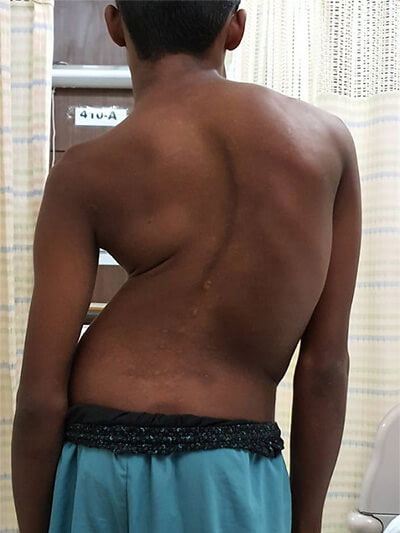
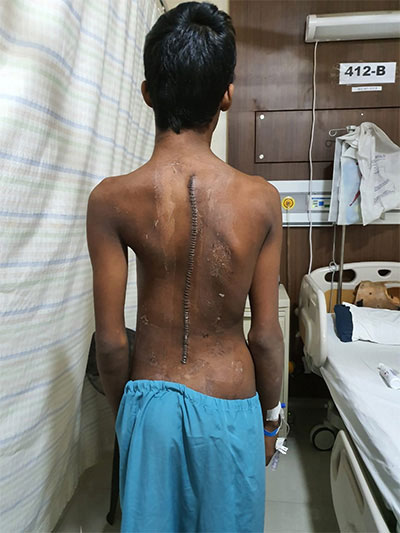
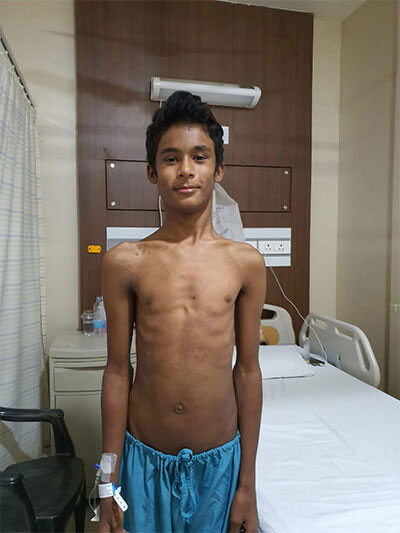
Scoliosis results in a sideways-curved spine which often appears to take on the shape of the letter “S”, while kyphosis is characterised by a spinal deformity manifesting as an abnormally curved upper back.
Fatima learned she had scoliosis when she was 10 years old. Growing up in Iraq, she did not have many options for treatment. By the time she was 12 years old, her spinal curvature increased to over 120 degrees, so nonoperative approaches were not possible. Despite knowing curves of this magnitude were potentially life threatening, several spinal specialists felt nothing could be done to correct her scoliosis. Her family began to lose hope.
The team performed a number of studies. "We felt the surgery was very complex, but possible," said her doctor. Yessica's mother emphasized, "We were very happy to know a team of experts were confident they could help her when local surgeons could not.”
Most surgeries of this type require 4-6 hours in the operating room, and a 3-5 day hospital stay. However, due to the severity and rigidity of her curves, Fatima had to spend additional time in the hospital to gently stretch her spine prior to surgery. "I felt myself growing every day, and this made it easier for me to breathe," said Fatima. On the day of surgery, the spinal specialists were very happy they could successfully straighten her curve in a single procedure.
Immediately after surgery, she could not believe how tall she was! "My spine felt straight, and I no longer had a large rib hump on my back," said Fatima. Her mother cried with happiness the first time she stood up after surgery.
It took some time to get used to her new body. She grew approximately 6 inches and no longer leaned to the side. Amazingly, within two weeks she did not need any more pain medication. Fatima was surprised she did not need a brace after her surgery, and she had no activity restriction. This allowed her to recovery much faster.
Now 1 year after surgery, Fatima is very happy with the way she looks. She regularly plays sports, and loves to dance.
